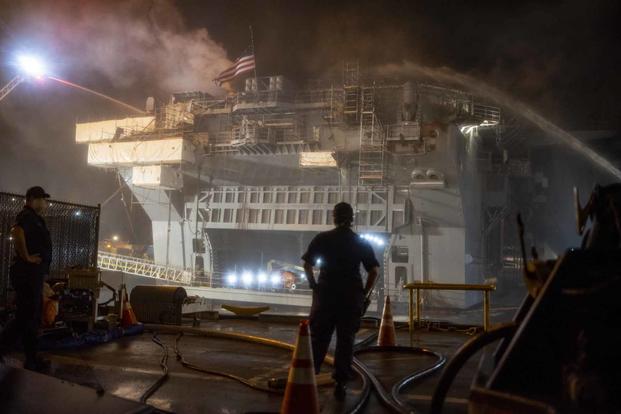It has been a year since a fire broke out on the amphibious assault ship Bonhomme Richard at Naval Station San Diego. Even after the ship's decommissioning, and at least two separate, ongoing investigations, the public knows little about what sparked the blaze.
Last week, Lt. Katie Diener, a Navy spokeswoman, said that the investigation into the "facts and circumstances" surrounding the July 12, 2020, fire is complete, but the results are being reviewed.
Naval Sea Systems Command directed questions on whether it is conducting a separate investigation back to Diener.
Pentagon Press Secretary John F. Kirby said, "The Navy is a much better place to go for an answer to that question," when asked about the investigation Monday.
Read Next: A British Soldier Smashed Through a Roof in California in a Botched Training Jump
Several mysteries still surround the fire, including reports of federal agents questioning a sailor in connection with the blaze.
Shortly after the fire was put out, Chief of Naval Operations Adm. Mike Gilday wrote in a memo to flag officers and master chiefs that "there were likely other contributing factors, but I won't speculate on that."
There could be several reasons for the silence and delay, according to Mark Nevitt, a former aviator and judge advocate attorney in the Navy, who spoke with Military.com about the investigation. Nevitt is now a professor at the Syracuse University College of Law.
Aside from the usual privacy and national security redactions, Nevitt said that pending criminal charges can delay an investigation.
"If you have a recommendation that is related to training, to readiness, to how watch is done, you don't have the same sort of criminal law due process concerns associated if [you] charge a Navy sailor with a violation of the Uniform Code of Military Justice," he explained.
Nevitt also noted that the Navy may have already taken some administrative action, "which could be non-judicial punishment," away from the public eye.
"Firing people ... removing people from the watchstand, or having people administratively separated for some kind of underlying administrative misconduct" are all things that could have already occurred, he said.
"It seems likely to me that, if there is a formal court-martial, that would take place following the completion of the investigation and the endorsements by the [Pacific Fleet] commander," Nevitt said.
Jeff Houston, a spokesman for the Naval Criminal Investigative Service, or NCIS, said that its investigation into the fire remains ongoing. Houston added that no charges have been filed at this time.
"Out of respect for the investigative process, NCIS does not comment on or confirm details relating to ongoing investigations," he said in a statement.
More broadly, Nevitt argues that the wait is understandable given the scope of the incident.
The fire began at about 8:30 am on July 12, 2020, in the ship's "Deep V" lower cargo hold, but it burned for four days, sometimes topping 1,200 degrees.
"As you are aware, the damage is extensive; there is fire and water damage, to varying degrees, on 11 of 14 decks," Gilday wrote in his memo. He added that it left sections of the ship's flight deck warped and bulging.
Teams from across several Navy commands and the San Diego Fire Department were involved in the effort, and 63 people -- 40 sailors and 23 civilians -- were hurt.
Nevitt explained that the review process that the investigation report is under right now can result in one of two outcomes. One possibility is that the commander of Pacific Fleet can endorse it fully -- meaning agree completely with the report. Nevitt added that this "is very rare." Alternatively, the commander, Adm. Samuel J. Paparo, can endorse it with recommendations or he could ask investigators "to look into other things that he thinks is worthy of looking into."
Nevitt said that similar incidents and investigations in the Navy's past could be instructive.
"The Miami's probably your best recent analogy," he said, referencing a 2012 fire aboard the attack submarine while it was in the Portsmouth Naval Shipyard in Maine.
The command investigation into that incident was completed in May 2013 -- almost exactly a year after the blaze. However, it was not made public until June 2014.
Navy leaders announced in November, four months after the blaze, that the Bonhomme Richard would be decommissioned after determining it would take at least $2.5 billion and five years to fix.
Dismantling of the ship began April 15.
-- Konstantin Toropin can be reached at konstantin.toropin@military.com. Follow him on Twitter @ktoropin.
Related: Navy Announces Timeline to Dismantle Fire-Damaged Bonhomme Richard, Sideline 2 LCSs












